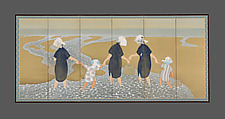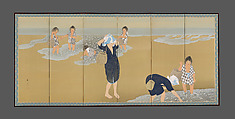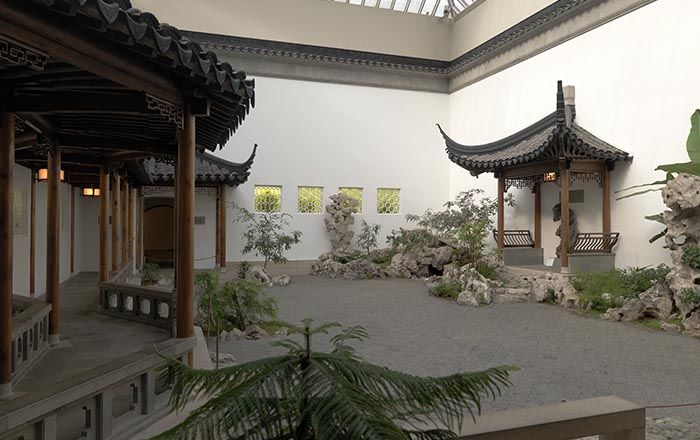After High Tide
Tsuji Kakō 都路華香 Japanese
Not on view
A group of five women and seven children gather shellfish along the seashore after the high tide, of a summer month, has receded. Against a glistening silk background (painted gold with an admixture of silver), the women wear deep azurite blue robes while donning kerchiefs with light blue patterns. Each of the children wears a robe with motifs borrowed from Rinpa pattern books, all rendered in mottled gold and ink. The diverse array of textile patterns may reflect the fact that the first owner of this deluxe set of screens was Fujii Zenshichi, the founding director of Maruike Fujii, the foremost textile wholesaler of the day in Kyoto.
Tsuji Kakō, one of the most esteemed artists of Nihonga, modern “Japanese-style painting,” was fascinated with water and wave patterns; these screens, with their dramatic treatment of abstracted water ripples and figures, have long been regarded as one of his most daring accomplishments. Though immensely popular with the public at the time it was first displayed at the Eleventh Bunten Exhibition in 1917, and featured on postcards that circulated widely throughout Japan, the screens’ whereabouts were unknown in the postwar period, and only came to light a few years ago.
The set of screens is a tour-de-force of technique in its expressive treatment of the waves and the intricate patterning of the women’s garments. It is also lavish in its application of traditional pigments of the highest quality that cover entire surface, leaving nothing in reserve: the tinted sky, receding ocean, golden sand, and figures that are painted in ink and thickly applied layers of mineral colors (possibly with the addition of Prussian Blue to augment the dark blue garments of the women). The animated appearance of the waves as well as the design elements on the children’s garments were achieved through the application of ink using a method called tarashikomi, a wet-on-wet painting technique.
This image cannot be enlarged, viewed at full screen, or downloaded.
This artwork is meant to be viewed from right to left. Scroll left to view more.










